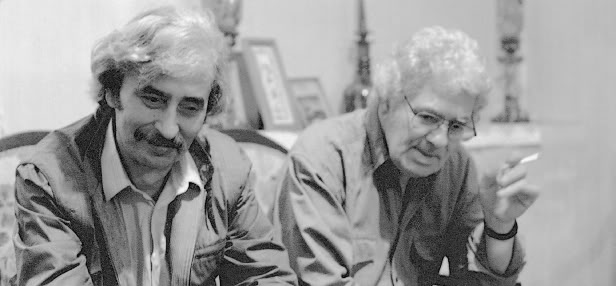
A Profile on Nosrat Rahmani (1929-2000)
The most challenging task in writing on Nosrat Rahmani’s poetry is to render the uniqueness of his poetical compositions in comparison with other forms of Iranian avant-garde poetry. The effort to unfold the innovative nature of his poetry, however, seems possible by a reference to Harold Bloom’s theorization of “the anxiety of influence” and his notion of “the strong poet,” the kind of a poet Rahmani was.
Harold Bloom, the American literary critic, has theorized “the anxiety of influence” as the individualistic endeavor of a poet to gain autonomy over his ancestor poets. Referring to both Freud’s psychoanalytic model and Nietzsche’s analysis of the tension between superstructures and the instinctual desire to overthrow them, Bloom defines the anxiety of influence as the struggle between the tradition of great writers and the desire for innovation in young, “belated” ones. He believes that we are belated sons of the fathers who have been superior to us. Yet, it would be lethal for us to accept our inferiority and to follow the rules of our precursors. This ambivalent relation to our literary ancestors is embodied in Bloom’s “the anxiety of influence,” which is a quest to gain self-governance by way of innovation for the winner of the battle, the strong poet.
Bloom believes that the aim of the strong poet to get into a fight with the ancestor is the declaration of himself as a self-created individual who is the master of his own fate while subverting the domination of his ancestors. He introduces “misprision,” the misunderstanding of the ancestral actual sources, as a departure from their influence which is a necessity for the strong poet to accomplish the project of self-creation. We are all latecomers, Bloom argues, arriving in a cultural setting that has been already made for us, and are given a preexisting language to express ourselves in this setting. In such a situation, most individuals follow the superstructures without challenging them, fitting themselves into typical roles and sacrificing their autonomy for being protected from the force of social order. However, it is Bloom’s strong poet who subverts literary -and social- consensus to earn individuality through a profound misreading and modification of traditions and superstructures.
Thinking of Nosrat Rahmani’s poetry through the Bloomian lense, one could identify him as the winner of the battle of the anxiety of influence. Like Bloom, Rahmani viewed poetry as a pre-existing linguistic setting, which makes it impossible for the latecomer poet to be entirely free from poetical structures that are imposed on his process of creation. However, he never ceased to challenge and complicate the literary legacy of his ancestors that he had adopted with his own daring innovations in his ingenious practice of poetry.
Born in 1929 in Tehran, Rahmani started his career in the Ministry of Post, Telegraph, and Telephone. Later, he joined the state radio, and then started to work as a journalist, contributing to some of the well-known magazines of the twentieth century including Ferdowsi (فردوسی), Tehran, Pictorial (تهران مصور), White and Black (سپید و سیاه), Hope for Iran (امید ایران), Woman of Today (زن روز). Rahmani began his professional poetry practice in the early 1940s. His debut poetry collection, Migration (کوچ), was published in 1954 and brought him instant fame. With Desert (کویر), and Termeh (ترمه) he established his poetic career and gained recognition as an avant-garde poet during the 1960s and 70s.
As Bloom’s strong poet, he was familiar with both the superstructure of rhyme, a legacy from the classical ancestors, and the contemporary Nimaic poetry. Rahmani borrowed the rhyme from the classic poetry and altered the length of the lines as Nima had started to do so in his contribution to Iranian modern poetry. However, he did not invest entirely on the legacy of both classical and modern ancestors. Rather, he combined the blend of classical and modern poetic forms with unusual poetic themes shaped by rarely-used words and phrases in Farsi. The result is a distinct experience of avant-garde poetry and an autonomous language that overcomes the anxiety of influence.
If Nima’s poetry, as Reza Baraheni explains in his book Nima Youshij: Modern Persian Poetry, is “the language of objects and birds, the language of animals, forests and the sea,” Rahmani’s poetry, which is influenced by Nimaic form, is filled with the colloquial language of ordinary urban people who lived under the political and social turmoil of the 1950s and 1960s. Still, Baraheni in an interview with IranWire, identifies Rahmani as the practitioner of Nima’s Romanticism, along with Fereydoon Moshiri and Nader Naderpour. However, just like Bloom’s strong poet, Rahmani later dismisses his poetry from the Romantic influence and pushes it to a more subversive practice filled with the gloomy atmosphere of the suppressed urban life of marginal groups and outcasts. This new articulation, which is still loyal to rhyme, echoes with the poetic practice of The Beat Generation, as Baraheni asserts in the same interview.
Rahmani’s unique expression of misery that departs from the thematic influence of his literary ancestors can be traced back to the beginning of his career as a poet which coincided with the distressing aftermath of the 1953 Iranian coup d’état. However, While the impact of that sour moment continues to live in his poetry, Rahmani’s thematization of misery and bitterness goes beyond a mere socio-historical observation to tie it to a very personal account of the (existential) absurdity and disappointment. Therefore, his poetry steers clear of the thematic influence of his ancestors and enters an internal and original world of his own, which questions both the sociohistorical and philosophical complications of being. As the winner of the anxiety of influence, however, the legacy Rahmani has left for Iranian avant-garde poetry is not the mere depiction of agony and dismay, but a subtle and skillful art of aestheticizing misery through an innovative expression of bitterness.
Works Cited
Bloom, Harold. The Anxiety of Influence, A Theory of Poetry. New York: Oxford University Press, 1997.
Baraheni, Reza. Nima Youshij: Modern Persian Poetry. Trans. Somaye Talebi, Leila Rasouli. Candle & Fog, 2014.
Biblio Brief:
Migration (کوچ). Tehran: 1954.
Desert (Kaveer(. Tehran: 1955.
Termeh (ترمه). Tehran: Khoosheh, 1957.
Rendezvous in mud (میعاد در لجن). Tehran: Nil, 1967.
Burning of the Wind (حریق باد). Tehran: Ketab-e- Zaman, 1970.
Harvest (درو). Tehran: Donya-ye- Ketab, 1970.
Pen’s Beloved: Sword (شمشیر: معشوقه قلم). Tehran: Bozorgmehr, 1989.
The Goblet Made Another Turn (پیاله دور دگر زد). Tehran: Bozorgmehr, 1990.
In the Battle of the Wind: Collection of Poems (در جنگ باد: گزیده اشعار). Tehran: Bozorgmehr, 1990.
The Honor of Love (آبروی عشق). Tehran: Pooyandeh, 2002.


Leave a Reply